Part 3: District health boards' audit results for 2010/11
3.1
Under section 15 of the Public Audit Act 2001, the Auditor-General audits the financial statements, accounts, and other information that each of the 20 DHBs and their subsidiaries are required to have audited each year. The Auditor-General does not audit PHOs because they are not public entities. The purpose of the annual audit is to give assurance that an entity's reports fairly reflect its financial and non-financial performance and do not mislead the reader.
3.2
In this Part, we discuss the 20 DHBs' audit results for 2010/11, including the audit opinion and our assessment of the environment, systems, controls, and non-financial reporting. During the year, we reviewed procurement practices and policies and examined DHBs' reporting of non-resident debt. We also report on these in this Part.
3.3
We report on the major work we carried out on DHB asset management in Part 4 and on DHB reporting on the reducing of health disparities for Māori in Part 5.
Non-standard audit reports
3.4
Three of the audit reports we issued in 2010/11 were non-standard.18
3.5
For the third time, we issued a modified opinion on Counties Manukau DHB's financial statements, for the way in which the DHB had treated "income in advance". We also issued reports with an "emphasis of matter" paragraph on a valuation issue for MidCentral DHB, and on Whanganui DHB's financial difficulties.
3.6
We have raised these matters with the DHB, the Minister, and the monitoring departments.
"Going concern" considerations
3.7
As part of an audit, appointed auditors consider whether it is appropriate for a DHB to prepare its financial statements on the basis of the "going concern" assumption. That assumption is appropriate when the DHB is expected to be able to operate for the foreseeable future, and at least for the next 12 months, taking account of all the available information. For 2010/11, there was significant concern about the ability of five DHBs to continue to operate for the foreseeable future – Capital and Coast, Southern, Wairarapa, West Coast, and Whanganui DHBs. Those DHBs and our auditors relied on a "letter of comfort" from the Ministers of Health and Finance in concluding that the going concern assumption was appropriate to use when preparing the financial statements.
Assessing the environment, systems, and controls
3.8
As part of the annual audits, our auditors comment on DHBs' management control environment, financial information systems and controls, and service performance information and associated systems and controls. We assign grades that reflect the recommendations for improvement that we make (see Figure 3).
Figure 3
Grading scale for assessing public entities' environment, systems, and controls
| Grade | Explanation of grade |
|---|---|
| Very good | No improvements are necessary. |
| Good | Improvements would be beneficial and we recommend that the entity address these. |
| Needs improvement | Improvements are necessary and we recommend that the entity address these at the earliest reasonable opportunity. |
| Poor | Major improvements are required and we recommend that the entity urgently address these. |
3.9
Our auditors assessed most of the DHBs as "good" for the management control environment and for financial information systems and controls for 2010/11. Thirteen DHBs were assessed as "good" for their service performance information and associated systems and controls (see Figure 4).
Figure 4
Summary of district health boards' 2010/11 grades for environment, systems, and controls
| District health board |
Management control environment |
Financial information systems and controls |
Service performance information and associated systems and controls |
|---|---|---|---|
| Auckland | Good | Good | Needs improvement |
| Bay of Plenty | Good | Good | Needs improvement |
| Canterbury | Very Good | Good | Good |
| Capital and Coast | Needs improvement | Needs improvement | Needs improvement |
| Counties Manukau | Good | Good | Good |
| Hawke's Bay | Good | Good | Good |
| Hutt Valley | Good | Needs improvement | Good |
| Lakes | Good | Good | Good |
| MidCentral | Good | Needs improvement | Needs improvement |
| Nelson-Marlborough | Good | Good | Good |
| Northland | Good | Good | Good |
| South Canterbury | Very Good | Good | Good |
| Southern | Good | Good | Good |
| Tairawhiti | Needs improvement | Needs improvement | Needs improvement |
| Taranaki | Good | Good | Good |
| Waikato | Good | Good | Good |
| Wairarapa | Good | Good | Needs improvement |
| Waitemata | Good | Good | Good |
| West Coast | Good | Good | Good |
| Whanganui | Good | Good | Needs improvement |
Trends in management control environment and in financial information systems and controls
3.10
In the last five years, there has been a slight trend toward improved grades in the management control environment and in financial information systems and controls. Figures 5 and 6 set out our grades for DHBs' management control environment, and financial information systems and controls, for the year ended 30 June 2011 and the four previous years.
Figure 5
Grades for district health boards' management control environment, 2006/07 to 2010/11
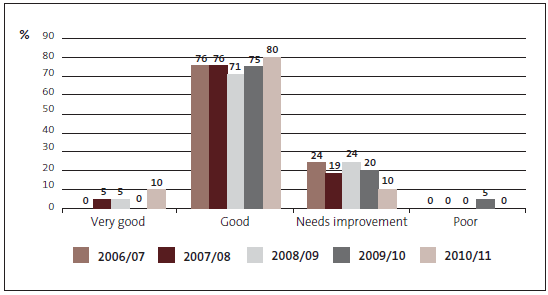
Figure 6
Grades for district health boards' financial information systems and controls, 2006/07 to 2010/11
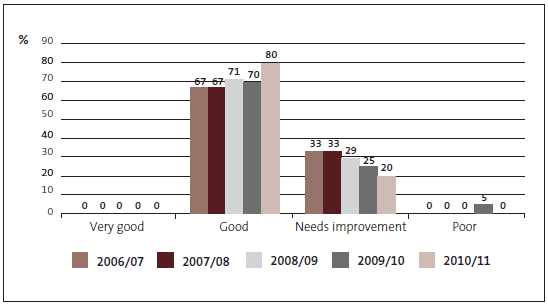
3.11
DHBs are now graded better in these two aspects than at any other time since 2006/07. We note that grades for a particular DHB can fluctuate from year to year, reflecting the circumstances of each DHB in each financial year. Some of the factors that can cause fluctuations include changes in the operating environment, standards, good practice expectations, audit emphasis, and whether the DHB has kept pace with good practice expectations between one year and the next. Nevertheless, there has been a fairly consistent move toward better grades.
3.12
We note that government departments, Crown research institutes, State-owned enterprises, and other Crown entities have achieved better grades than DHBs, in 2010/11 and for earlier years. Between 38% and 81% of other types of public entities achieved a "very good" grade for their management control environment for 2010/11. Only 10% of DHBs did (see Figure 7).
Figure 7
Grades for management control environment by type of entity, 2010/11
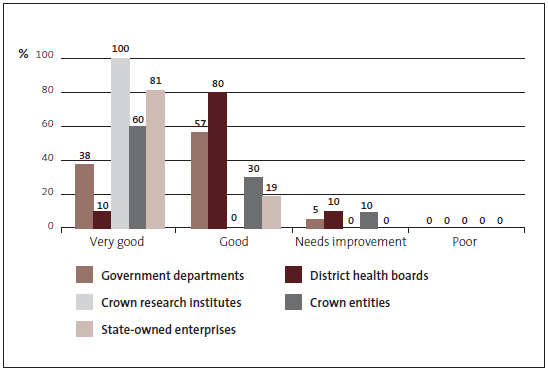
Note: The "Crown entities" included here are those categorised as statutory entities under the Crown Entities Act 2004, excluding DHBs.
3.13
Between 31% and 62% of other types of public entities were graded "very good" for financial information systems and controls for 2010/11. By comparison, no DHBs were graded "very good" (see Figure 8).
Figure 8
Grades for financial information systems and controls by type of entity, 2010/11
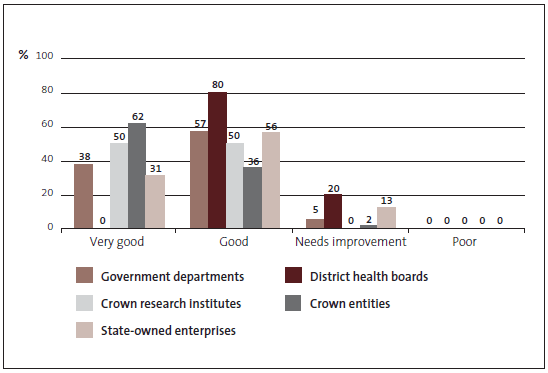
Note: The "Crown entities" included here are those categorised as statutory entities under the Crown Entities Act 2004, excluding DHBs.
Non-financial performance reporting
3.14
In 2008/09, we issued a grade for entities' service performance information and associated systems and controls for the first time. We graded all DHBs as "poor/needs improvement". DHBs did not identify clearly or comprehensively the services that they delivered. The quality of measures for outcomes and for services provided was poor.
3.15
DHBs' non-financial reporting improved considerably during the last two years, after significant work by the DHBs individually and regionally, and by the Ministry. Figure 9 shows the audit results for 2008/9, 2009/10, and 2010/11.
Figure 9 Grades for district health boards' service performance information and associated systems and controls, 2008/09 to 2010/11
| Grade | Number (%) of DHBs | ||
|---|---|---|---|
| 2008/09 | 2009/10 | 2010/11 | |
| Very good | 0 | 0 | 0 |
| Good | 0 | 0 | 13 (65%) |
| Needs improvement | – | 12 (60%) | 7 (35%) |
| Poor | – | 8 (40%) | 0 |
| Poor/needs improvement | 21 (100%) | – | – |
3.16
The 2010/11 results are a marked improvement from 2009/10, when no DHBs were graded "good". DHBs now lead the other Crown entities and government departments in the proportion of entities rated "good" for service performance information and associated systems and controls (see Figure 10).
Figure 10
Grades for service performance information and associated systems and controls by type of entity, 2009/10 and 2010/11
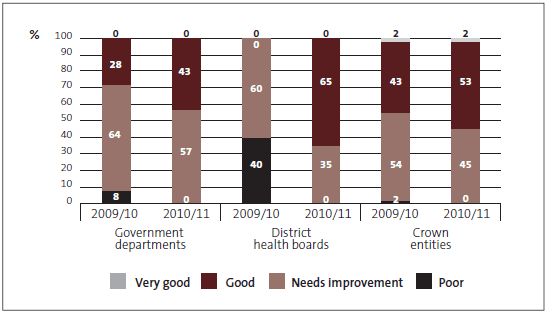
Note: The "Crown entities" included here are those categorised as statutory entities under the Crown Entities Act 2004, excluding DHBs. Percentage figures have been rounded and might not add up to 100.
3.17
Our auditors have worked with individual DHBs, and we have provided the Ministry and DHBs with comparative information on performance information reporting by DHBs. We have also published good practice examples from the previous year's statements of intent (see our 2011 publication, District health boards: Learning from 2010-13 Statements of Intent).
3.18
We continue to focus on whether each DHB's service performance information presents a performance story that is clear, logical, and understandable, and that:
- provides a basis for assessing how effectively the DHB responds to its strategic priorities and achieves its intended outcomes;
- links financial information and good quality non-financial performance information to provide a basis for assessing cost-effectiveness; and
- describes its services clearly and concisely, particularly the quality of those services.
3.19
During the past three years, we have focused on helping DHBs to improve their statements of intent, on the assumption that better annual reporting of performance will follow. DHBs need to continue to work on this. We will apply a revised auditing standard to DHBs' performance reporting in 2012/13.
3.20
We intend to provide examples of good practice in annual reporting to help DHBs with their ongoing improvement.
Procurement
The procurement environment
3.21
DHBs carry out much procurement and that carries with it risks to DHBs' effectiveness and efficiency. In July 2010, the Government established Health Benefits Limited (HBL) to improve DHBs' procurement processes (among other matters).
3.22
In past years, our auditors have reviewed DHBs' procurement policies and practices. In September 2010, we published Spending on supplies and services by district health boards: Learning from examples, which identified areas for improvement and provided guidance to enhance the effectiveness and efficiency of procurement in contributing to a DHB's business. During our 2010/11 audit, we followed up that report by looking at whether DHBs had prepared a plan and/or systems to improve their procurement practices. We found that, although improving, procurement practices continue to be an area of risk.
3.23
DHBs use about half of their funding to pay other organisations to deliver health services. These third parties are often not public entities. Usually, the DHB manages its risks in these third-party arrangements through a chain of "back-to-back" contracts19 to ensure that services of the right quality are delivered as and when required.
3.24
In the audits for 2010/11, we considered whether "back-to-back" contracts for health services were ensuring that health resources were not wasted and that the required services were provided to the specified standards and in a publicly acceptable way. At the same time, we identified whether the DHB was using "high trust" contracting20 to reduce the compliance burden of contracting.
3.25
Below, we summarise where, in a "third party" environment, DHBs can improve further on their procurement practice and procurement generally.
Enhancements needed in procurement
3.26
DHBs could further improve their procurement practice by:
- Taking a more strategic approach. A procurement strategy would draw together policies and approaches and provide a framework that allows procurement to better contribute to corporate objectives. Several DHBs have been awaiting clarity about the services that will fall under the control of HBL, and procurement leadership from HBL. In our view, there is a risk in their waiting, and DHBs ought to have a procurement plan for 2011/12 to show which of the main issues in procurement they intend to address. We note that DHBs have been working together to achieve a more strategic procurement planning approach.
- Co-ordinating procurement management arrangements. In our view, greater co-ordination across the organisational arms of each DHB would improve the quality of procurement activity, as would entity-wide reporting backed by a sound procurement review process. DHBs must consider whether they have enough skilled staff to carry out the procurement function effectively and efficiently.
- Considering ethics and legality. DHBs need to ensure that they have sufficiently assessed and investigated potential conflicts of interest, especially where former staff have been appointed as contractors.
Procurement in a "third party" environment
3.27
Our auditors did not report any difficulties with DHBs' management of "back-to-back" contracts.
3.28
We are aware that small-scale health service providers believe that DHBs could use "high trust" and integrated21 contracts to better effect. Our auditors reported little evidence of "high trust" contracts, some remarking that the DHB had only recently begun using them. However, we are aware that Whānau Ora developments in the wider government sector, in which the health sector has a major role, are beginning to affect the contracting environment, with more use of "high trust" and integrated contracts.
3.29
In our view, DHBs could continue to explore more effective and efficient procurement arrangements, such as reducing reporting requirements, perhaps through more and better use of "high trust" and integrated contracts with third-party providers, whether or not this is within a particular Whānau Ora initiative.
3.30
In our view, the Ministry needs to continue to encourage DHBs' efforts to do so. We will maintain our focus on the issue in future audits.
Managing the debt of ineligible patients
3.31
Health or disability services in New Zealand's public hospitals are generally free or subsidised for New Zealand residents, and some other categories of eligible people who meet certain clinical and other assessment criteria.22
3.32
If DHBs fail to identify or collect payment from ineligible patients, the DHB must meet the costs of their treatment (reducing the funds available for other services). These costs ultimately fall on the New Zealand taxpayer.
3.33
We have been told that there is some anxiety in the community that DHBs might, in trying to identify ineligible patients, place a burden of proof on patients that is unreasonable. The concern was that, for example, health service providers might start asking vulnerable patients (such as frail elderly New Zealanders with no proof of residency immediately on hand) for proof that they are eligible for free or subsidised treatment.
3.34
It was in this context that, in 2010/11, HBL "worked closely with DHBs to improve revenue collection from patients ineligible for free healthcare, by reviewing practices to build a best practice guide".23 The guide was distributed in May 2011 to the DHB teams that deal with matters of patient eligibility.
3.35
HBL reported that, at the time of its 2010/11 annual report, it had not yet determined whether its targeted additional saving from improved collection of non-resident revenue had been achieved. This was because DHBs do not routinely report specific data about revenue collected from and owed by ineligible patients, and the relevant data from DHBs was not available at that time.24
3.36
However, HBL said that 2010/11 data collected from the northern region showed a net gain of about $6.5 million in revenue collected from ineligible patients, as a result of a wide range of activity and initiatives.25 Therefore, it appears that there are savings to be made in this area, although HBL was not able to determine the aggregate amount for 2010/11.
3.37
We also had difficulty gathering this data for 2010/11. DHB revenue was not detailed by source (eligible/ineligible patients) in DHBs' annual reports. Neither, in general, did DHBs report on the level of revenue, debt, or debt write-off, by type (non-resident).
3.38
HBL told us that it has asked DHBs to report ineligible patient and non-resident revenue, and associated bad debts, each month from 1 July 2011, and that arrangements have been made to record this information.
3.39
Collection of debt is not the sole focus of debt management. There is also the question of whether DHBs are identifying ineligible patients correctly, and, if not, what barriers to correct identification there are.
3.40
HBL told us that it is producing further best practice material for DHBs. Also, the Ministry has been working on improving data-matching to increase the accuracy of identifying non-resident patients. This work indicates that there may be a large issue with providers receiving per capita subsidies for patients who are non-resident and ineligible. The Ministry is taking action on this issue. At the same time, as we have noted above, there is a need for an approach to identifying who is eligible and who is not that does not place an unreasonable burden of proof on vulnerable New Zealanders.
3.41
We will continue to monitor the Ministry's and HBL's progress in helping DHBs to improve identification and recovery of the cost of treatment and/or subsidy of ineligible patients, in a way that is effective but not onerous for New Zealand citizens, especially the vulnerable.
18: A non-standard audit report is one that contains a modified opinion and/or an "emphasis of matter" or an "other matter" paragraph. There are three types of modified opinion (an "adverse" opinion, a "disclaimer of opinion", and a "qualified opinion"). An adverse opinion is the most serious type of non-standard audit report.
19: A "back-to-back" contract is where the DHB passes its own responsibilities to health service users to the provider of those health services (which the DHB funds). By enforcing the contract, the DHB can ensure that its responsibilities and obligations can and will be met.
20: A "high trust" approach is now being taken in contracts of the Ministry of Social Development and in the Whānau Ora initiative. It typically consists of:
- a simple funding agreement of no more than three pages;
- funding paid up front in one annual instalment;
- meaningful annual reporting focusing on outcomes, with results agreed and described, and flexibility about service delivery; and
- a customised approach to meeting the holistic needs of families.
21: The Ministry of Social Development developed integrated contracts to merge several agencies' contractual requirements of a service provider, with the aim of reducing the compliance burden.
22: Eligibility criteria are explained on the Ministry's website, www.health.govt.nz.
23: Health Benefits Limited Annual Report 2011, page 6.
24: Health Benefits Limited Annual Report 2011, page 12.
25: Health Benefits Limited Annual Report 2011, page 12.
page top